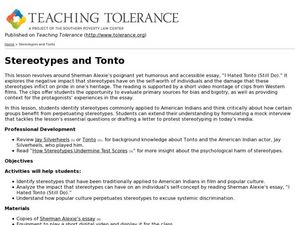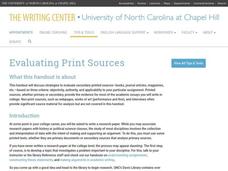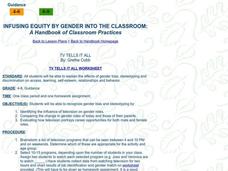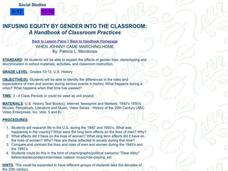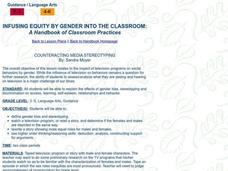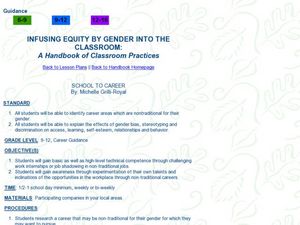Curated OER
Holes
Students distinguish between primary and secondary sources when researching on the Internet and evaluating historical records. They recognize important features of a primary source such as the type of document, who created it, what is...
Curated OER
Stereotypes and Tonto
Students identify stereotypes, especially those applied to American Indians. In this teaching tolerance instructional activity, students read an essay entitled " I Hated Tonto (Still Do)" and discuss the negative impact that...
Curated OER
Evacuation: The Japanese Americans in World War II
Students examine Japanese internment camps of World War II. In this World War II lesson, students use primary and secondary sources to research the evacuation process and life within the internment camps. Students discuss the racial bias...
Curated OER
Using Primary Source Documents in the Classroom
Students use primary documents to explore the past. They consider the source of the documents and identify and biases that the author may have held. They identify any questions about the historical event that may remain after reading the...
Curated OER
The President's Day Has Arrived
Students state and defend their opinions regarding all aspects of the impeachment proceedings against President Clinton after completing a survey and researching the topic. They also consider opinion polls, media bias and global politics.
Curated OER
10 Logic
In this algebra worksheet, students define and use not, and, or. They also discuss how biased or valid a test is. They apply logic to solving real life scenarios and word problems.
Curated OER
Fort Wayne's Industrial Girls
Eighth graders explore what life was like for Fort Wayne's "industrial girls." In this industrialization instructional activity, 8th graders discuss the conditions that the Indiana factory girls worked in as well as their backgrounds....
University of North Carolina
Evaluating Print Sources
Not all sources are created equal, so how do you evaluate them? Writers learn how to evaluate print sources based on elements such as audience, tone, and argument in the sixth handout of 24 in the Writing the Paper series from the...
Newseum
Is It Fair?
Young journalists learn how to analyze word choice, context, and counterpoints to judge the fairness of a news story. They practice using these tools to judge a series of headlines for the story of Goldilocks and the Three Bears. They...
Michigan State University
Researching and Compiling Survey Information
Bring Internet research and social issues to your language arts class in this activity. After investigating the topic "Media Violence and How It Affects Teenagers" on the Internet, middle schoolers work in groups to compile their...
Peace Corps
Culture is Like an Iceberg
What influences the way you dress, or celebrate holidays, or connect with your friends? Explore the cultural traits that are not easily seen with an engaging discussion. Using the model of an iceberg, learners place features of culture...
Curated OER
TV TELLS IT ALL
Young scholars identify the influence of television on gender roles and talk about how they are changing.
Curated OER
WHEN JOHNNY CAME MARCHING HOME
Students examine the roles of men and women throughout history.
Curated OER
What's on the Outside/Inside?
Students read about the idea of gender perspective in the writing of German history. They generate definitions from a list of given vocabulary words. They write definintions using their own words.
Curated OER
Ports in the Storm
Students explore national security issues related to the possibility of a Dubai-owned company operating an American port. Opinions are solicited and debated.
Curated OER
On the Air
Students explore the issue of race in television since the 1950's, focusing specifically on African-American entertainers. After researching important issues, events, and television personalities of specific decades, students create TV...
Curated OER
DETERMINING THE EXISTENCE OF GENDER BIAS IN DAILY TASKS
Students identify task assignments by gender.
Curated OER
Designing Samples/Simple Random Samples
Students explore the concept of sampling techniques. In this sampling techniques lesson, students identify possible sources of bias in situations such as phone polls, supermarket surveys, and drawing names from a phone book. Students...
Curated OER
COUNTERACTING MEDIA STEREOTYPING
Students explore the effects of gender bias, stereotyping, and discrimination.
Curated OER
I can do What I Want
Learners recognize gender bias and stereotyping. For this self-esteem lesson, students listen to Amazing Grace by Mary Hoffman and discuss how girls can be successful and provide positive role models for others.
Curated OER
EMOTIONS AND GENDER EQUITY
Students discuss emotions and decide as a group which emotions are O.K. for males/females. They discuss solutions to gender bias in terms of the different emotions and write a reflective essay about what they learn from the discussion.
Curated OER
Infusing Equity by Gender into the Classroom: School to Career
Students identify nontraditional career areas for their gender and discuss gender bias and stereotyping. In this nontraditional careers activity, students research a nontraditional career and shadow the job in the workplace. ...
Curated OER
Dissecting the Media
Students examine an editorial point of view in journalism and explore how this contributes to the West's understanding of events in the Middle East. They discuss the concepts of objectivity and subjectivity, and how tone and vocabulary,...
Curated OER
Samples and Stats
Students explore different methods of taking surveys and conducting polls and examine these methods for bias. They design and administer a sample survey, analyze the data and present their findings to the class.

